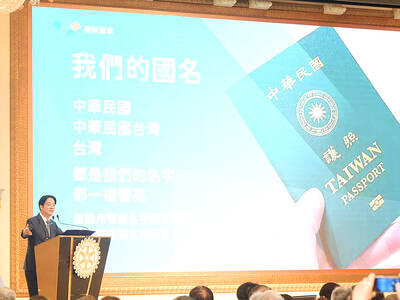Japan’s trade surplus grew last month for the first time in 20 months as an export slump eased, data showed yesterday, supporting hopes the world’s No. 2 economy is crawling toward a recovery.
The surplus jumped roughly five-fold to ¥508 billion (US$5.4 billion), from ¥104.1 billion a year earlier, the finance ministry reported.
Exports exceeded imports for a fifth straight month, giving a vital boost to a country whose heavy dependence on overseas demand left it highly exposed to the global economic downturn.
The year-on-year improvement in the trade balance, the first since October 2007, reflected a smaller decline in exports and a sharp fall in imports.
Exports sank 35.7 percent from a year earlier to ¥4.6 trillion, after a 40.9 percent plunge in May, while imports dived 41.9 percent to ¥4.1 trillion.
“Exports are improving. What had been most worrying were shipments to the United States, but they shrank less than before,” Daiwa Institute of Research economist Hiroshi Watanabe said.
US-bound exports were down 37.6 percent from a year earlier, compared with drops of more than 40 percent in April-May and more than 50 percent in January-March.
Watanabe said a credit crunch that had squeezed demand for cars and other products was now easing, supporting overseas demand for Japanese goods.
Exports should keep improving through this year, but companies still need to shed excess jobs and manufacturing facilities, he added.
Japan posted a trade surplus of ¥3.9 billion with China, the first black ink in four months, while the surplus with the EU dived 71.6 percent to ¥90.5 billion for a 10th consecutive decline.
Government stimulus spending efforts are gradually helping to boost demand for Japanese goods, but the recovery is patchy, said Hideyuki Araki, an economist at Resona Research Institute.
“It is mostly large companies that are benefiting from other countries’ economic packages and smaller firms are still struggling. Overall production activity is recovering but lacks strength,” he said.
For the six months to last month, Japan posted a trade surplus of ¥8.3 billion, down 99.7 percent from a year earlier but marking a turnaround from a deficit of ¥766.3 billion in the second half of last year.

LONG FLIGHT: The jets would be flown by US pilots, with Taiwanese copilots in the two-seat F-16D variant to help familiarize them with the aircraft, the source said The US is expected to fly 10 Lockheed Martin F-16C/D Block 70/72 jets to Taiwan over the coming months to fulfill a long-awaited order of 66 aircraft, a defense official said yesterday. Word that the first batch of the jets would be delivered soon was welcome news to Taiwan, which has become concerned about delays in the delivery of US arms amid rising military tensions with China. Speaking on condition of anonymity, the official said the initial tranche of the nation’s F-16s are rolling off assembly lines in the US and would be flown under their own power to Taiwan by way

OBJECTS AT SEA: Satellites with synthetic-aperture radar could aid in the detection of small Chinese boats attempting to illegally enter Taiwan, the space agency head said Taiwan aims to send the nation’s first low Earth orbit (LEO) satellite into space in 2027, while the first Formosat-8 and Formosat-9 spacecraft are to be launched in October and 2028 respectively, the National Science and Technology Council said yesterday. The council laid out its space development plan in a report reviewed by members of the legislature’s Education and Culture Committee. Six LEO satellites would be produced in the initial phase, with the first one, the B5G-1A, scheduled to be launched in 2027, the council said in the report. Regarding the second satellite, the B5G-1B, the government plans to work with private contractors

‘OF COURSE A COUNTRY’: The president outlined that Taiwan has all the necessary features of a nation, including citizens, land, government and sovereignty President William Lai (賴清德) discussed the meaning of “nation” during a speech in New Taipei City last night, emphasizing that Taiwan is a country as he condemned China’s misinterpretation of UN Resolution 2758. The speech was the first in a series of 10 that Lai is scheduled to give across Taiwan. It is the responsibility of Taiwanese citizens to stand united to defend their national sovereignty, democracy, liberty, way of life and the future of the next generation, Lai said. This is the most important legacy the people of this era could pass on to future generations, he said. Lai went on to discuss

MISSION: The Indo-Pacific region is ‘the priority theater,’ where the task of deterrence extends across the entire region, including Taiwan, the US Pacific Fleet commander said The US Navy’s “mission of deterrence” in the Indo-Pacific theater applies to Taiwan, Pacific Fleet Commander Admiral Stephen Koehler told the South China Sea Conference on Tuesday. The conference, organized by the Center for Strategic and International Studies (CSIS), is an international platform for senior officials and experts from countries with security interests in the region. “The Pacific Fleet’s mission is to deter aggression across the Western Pacific, together with our allies and partners, and to prevail in combat if necessary, Koehler said in the event’s keynote speech. “That mission of deterrence applies regionwide — including the South China Sea and Taiwan,” he